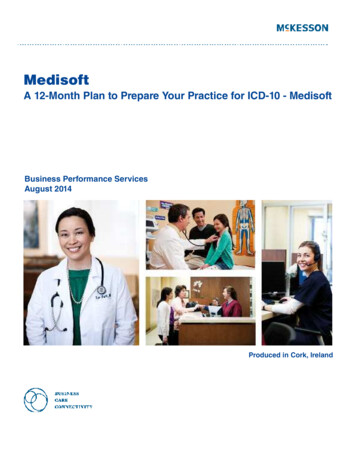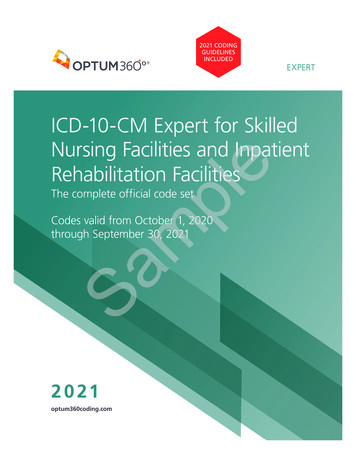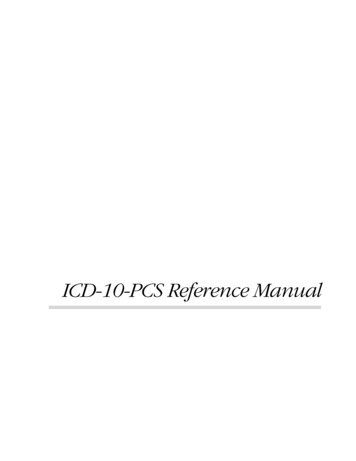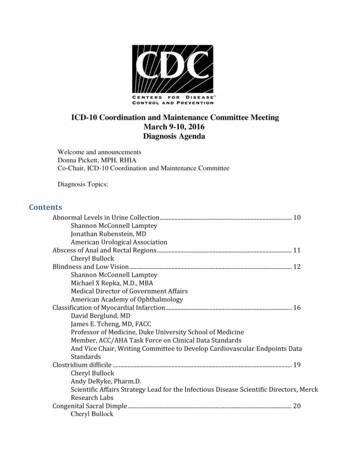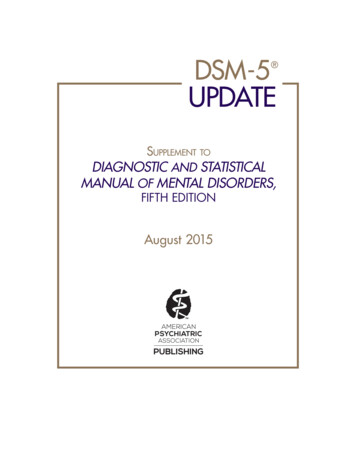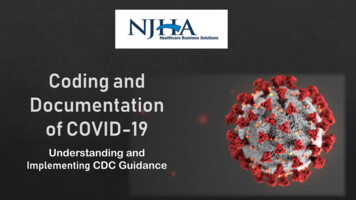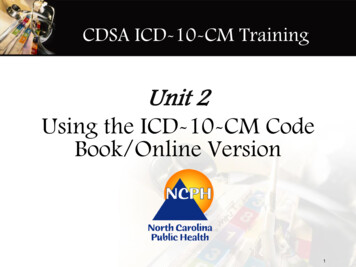
Transcription
CDSA ICD-10-CM TrainingUnit 2Using the ICD-10-CM CodeBook/Online Version1
Training Objectives1. Understand the structure of the ICD-10-CM Code Bookand online resources2. Understand how to look up diagnoses in the AlphabeticalIndex and verify the code in the Tabular List3. Understand the coding conventions and coding guidelines4. Demonstrate how to accurately assign ICD-10-CM codesto a CDSA scenario and some simple diagnoses2
Training Essentials The CDSA ICD-10-CM training is broken down into units– Staff should review the Training Objectives for each unit to determine theextent of training needed to perform their job functions– Staff that want to utilize all of the training should complete the units insequential order (e.g., Unit 1 then Unit 2, etc.) ICD-10-CM Coding Training Workbook for CDSAs– tm– See “CDSA Training Materials” In order to complete this training, access to ICD-10-CM codebook or downloads of the 2016 version of ICD-10-CM from theCMS website is needed– 10-CM-and-GEMs.html Webinar basics– Pause/Play– Back/Forward3
Online version of 2016-ICD-10CM-and-GEMs.html4
Online version of 2016-ICD-10CM-and-GEMs.html5
Alphabetic Index– Index to Diseases andInjuries6
Alphabetic Index– Index to Diseases andInjuries7
Alphabetic Index –Table of Drugs andChemicals8
Alphabetic Index –Table of Neoplasms9
Alphabetic Index - Index to ExternalCause of Injuries10
Tabular List of Diseases and Injuries11
Tabular List of Diseases and Injuries12
Added Features to ICD-10-CMICD-10-CM includes full code titles for all codes No referencing back to common 4th and 5th digitsICD-9-CM– 756 Other congenital musculoskeletal anomalies 756.1 Anomalies of spine– 756.19 OtherICD-10-CM– Q76 Congenital malformation of spine and bony thorax Q76.4 Other congenital malformations of spine, not associatedwith scoliosis– Q76.41 Congenital kyphosis Q76.411 Congenital kyphosis, occipito-atlanto-axialregion13
Alphabetic Index – Main Terms Alphabetic Index and Tabular List– Structured the same as ICD-9-CM– Look up: hard cleft palate with bilateral cleft lip14
Similarities Between 9 and 10Alphabetic Index Many convention types have same meaning in the Tabular List andAlphabetic Index:– Instructional notes– Abbreviations and Symbols– Punctuation marks Alphabetic index includes suggestions for manifestation codes15
ICD-10-CM Official Guidelines for Codingand Reporting A set of rules developed by the National Center for HealthStatistics (NCHS) that accompany and complement theofficial conventions and instructions provided within theICD-10-CM– The instructions and conventions of the classification takeprecedence over the guidelines– HIPAA requires adherence to the official coding guidelines in allhealthcare settings Sections 1 and 4 of the guidelines apply to outpatients Updates are published at least annually– /icd10cm-guidelines-2016.pdf16
Added Features to ICD-10-CM Consists of 21 Chapters compared to 17 in ICD-9-CM– Sense organs are no longer in the nervous system disorders – they havetheir own Chapters Diseases of the Eye and Adnexa (Chapter 7) Diseases of the Ear and Mastoid Process (Chapter 8)– V and E codes are no longer supplemental classifications - They havetheir own Chapters E codes are now in Chapters 19 and 20– Injury, poisoning and certain other consequences of external causes(Chapter 19)» T42.5x1 Poisoning by mixed antiepileptics, accidental (unintentional)– External causes of morbidity (Chapter 20)» Y79.1 Therapeutic (nonsurgical) and rehabilitative orthopedic devicesassociated with adverse incidents V codes are now in Chapter 21: Factors influencing health status andcontact with health services17
Similarities Between 9 and 10Chapters of ICD-10-CM18
Similarities Between 9 and 10Tabular List Tabular List Example – Chapter 1619
Similarities Between 9 and 10Tabular List Tabular List Example – Chapter 16 (cont’d)– Each chapter in the Tabular List begins with a summary of code blocks20
Similarities Between 9 and 10Tabular List Tabular List Example – Blocks of Codes21
Instructional NotesIncludes “Includes” – In Tabular List, defines and/or gives examplesof the content of a chapter, section, category, or block ofcategory codes (subcategory)– Includes list is not exhaustive so even though a documented diagnosisis not on the list, the code may still be appropriateE10 Type 1 diabetes mellitusIncludes: brittle diabetes (mellitus)diabetes (mellitus) due to autoimmune processdiabetes (mellitus) due to immune mediated pancreatic islet beta-cell destructionidiopathic diabetes (mellitus)juvenile onset diabetes (mellitus)ketosis-prone diabetes (mellitus)E10.1 Type 1 diabetes mellitus with ketoacidosisE10.10 Type 1 diabetes mellitus with ketoacidosis without comaE10.11 Type 1 diabetes mellitus with ketoacidosis with coma22
Instructional NotesIncludes At the code level, there may be a list of terms included in thecode but the term “includes” is not used ExampleE10.2 Type 1 diabetes mellitus with kidney complicationsE10.21 Type 1 diabetes mellitus with diabetic nephropathyType 1 diabetes mellitus with intercapillary glomerulosclerosisType 1 diabetes mellitus with intracapillary glomerulonephrosisType 1 diabetes mellitus with Kimmelstiel-Wilson diseaseE10.22 Type 1 diabetes mellitus with diabetic chronic kidney diseaseType 1 diabetes mellitus with chronic kidney disease due to conditions classifiedto .21 and .22Use additional code to identify stage of chronic kidney disease (N18.1-N18.6)E10.29 Type 1 diabetes mellitus with other diabetic kidney complicationType 1 diabetes mellitus with renal tubular degeneration23
Instructional NotesExcludes1 Excludes1 note– Indicates that the code(s) excluded should never be used at thesame time as the code above the “Excludes1” note - the 2conditions cannot occur together– In other words: NOT CODED HERE– Example:E10 Type 1 diabetes mellitusExcludes1: diabetes mellitus due to underlying condition (E08.-)drug or chemical induced diabetes mellitus (E09.-)gestational diabetes (O24.4-)hyperglycemia NOS (R73.9)neonatal diabetes mellitus (P70.2)postpancreatectomy diabetes mellitus (E13.-)postprocedural diabetes mellitus (E13.-)secondary diabetes mellitus NEC (E13.-)type 2 diabetes mellitus (E11.-)24
Instructional NotesExcludes2 Excludes2 note– Indicates that the condition excluded is not part of thecondition represented by the code, but a client may have bothconditions at the same time– In other words: NOT INCLUDED HERE25
Instructional NotesExcludes Notes - Question Question 1: Could you code Q71.62, “Lobster-claw, lefthand” (which falls within the range of Q71-Q73) and“Congenital torticollis” (Q68.0) for same encounter? Question 2: Could you code both “Congenital torticollis” and“Congenital myotonic chondrodystrophy” (G71.13) for sameencounter?26
Instructional Notes“See” Notes Cross reference notes are “See”, “See also”, “See condition” “See” – instructs you to look elsewhere “See also” – there is another place to look if the code is notlisted here27
Instructional Notes“See” Notes “See condition” – means the term used to look up thediagnosis is not appropriate to identify the code– Example from Alphabetic IndexPalate —see condition– For Cleft Palate, the condition is ‘Cleft’28
Instructional Notes“Code” Notes “Code First” – select a code to:– represent the etiology that caused the manifestation and sequence that 1st– provide coding sequence guidance29
Instructional Notes“Code” Notes “Use Additional Code” – assign an additional secondary code– to identify the manifestation due to the underlying etiology– to provide coding sequencing guidance30
Abbreviations NEC – Not Elsewhere Classifiable– Other types of specified conditions not classified anywhere else in ICD10-CM– Alphabetic Index uses NEC in code descriptions to direct the coder to theTabular List showing a ‘not elsewhere classified’ code description31
Abbreviations NOS – Not Otherwise Specified– Used in Alphabetic Index and Tabular List when clinicaldocumentation is insufficient to assign a more specific code– Equivalent of “Unspecified”32
Symbols and Punctuation Marks Point Dash symbol .– In the Aphabetical Index and Tabular List, used to indicate a code isincompleteMembranacea placenta O43.19- Comma ,– Separate synonyms or essential modifiers follow the commaMeningococcus, meningococcal (see also condition) A39.9- adrenalitis, hemorrhagic A39.1 Parentheses ( ) – used in Alphabetic Index and Tabular List– Placed around supplementary words that may be present or absent in thedisease statement in the clinical documentation These terms are known as nonessential modifiers Nonessential modifiers do not affect code assignment In tabular, used when codes are included– Diabetes, diabetic (mellitus) (sugar) E11.9– E11 Type 2 diabetes mellitusUse additional code to identify any insulin use (Z79.4)33
Punctuation Marks Brackets [ ] - used in Alphabetic Index and Tabular List– Alphabetic Index - identify manifestation codes– Tabular List - enclose synonyms, alternative wordings, or explanatoryphrases Colon : - used in Tabular List– Used with “Includes”, “Excludes”, “Note” or after an incomplete termthat needs one or more of the modifiers following the colon to make itassignable to a given category34
Relational Terms “and” - when used within a code title in Tabular List, means“and/or”M24.87 Other specific joint derangements of ankle and foot, not elsewhere classifiedM24.871 Other specific joint derangements of right ankle, not elsewhere classifiedM24.872 Other specific joint derangements of left ankle, not elsewhere classifiedM24.873 Other specific joint derangements of unspecified ankle, not elsewhere classifiedM24.874 Other specific joint derangements of right foot, not elsewhere classifiedM24.875 Other specific joint derangements left foot, not elsewhere classifiedM24.876 Other specific joint derangements of unspecified foot, not elsewhere classified35
Relational Terms “with” - means “associated with” or “due to”– Alphabetical Index -Used in code titles; sequenced immediatelyfollowing the main term (not in alphabetical order)– Tabular List - Used in instructional notes36
Other Coding GuidelinesDefault CodesDefault code – In the Alphabetic Index, a code listed next to a mainterm Condition most commonly associated with the main term; orUnspecified code for the condition37
Other Coding GuidelinesCombination Codes Combination Codes are single codes used to classify:– Two diagnoses J35.03 Chronic tonsillitis and adenoiditis– Diagnosis with associated secondary process (manifestation) P24.31 Neonatal aspiration of milk and regurgitated food with respiratory symptoms– Diagnosis with associated complication Q05.2 Lumbar spina bifida with hydrocephalus Combination codes are identified by:– Subterm entries in Alphabetic Index– Instructional notes in the Tabular List Multiple coding should not be used when the classificationprovides a combination code that clearly identifies all of theelements documented in the diagnosis When the combination code lacks necessary specificity indescribing the manifestation or complication, an additional codeshould be used as a secondary code38
Other Coding GuidelinesFirst Listed Codes Golden Rule: List first the code for the diagnosis, condition,problem, or other reason for encounter shown in the clientrecord to be chiefly responsible for the services provided– In some cases the first-listed diagnosis may be a symptom when adiagnosis has not been established/confirmed by the clinician List additional codes that describe any coexisting condition– Code all documented conditions that coexist at the time of theencounter and require or affect the client’s treatment or management Do not code conditions that were previously treated but no longerexist39
Other Coding GuidelinesFirst Listed Codes9-month old girl who was born prematurely at 32-weeksgestation. History of reflux, slow weight gain, head tilt to left.Referred for concern of delayed gross motor skills. Physical examsignificant for occipital-parietal flattening on the right side(plagiocephaly) and mild torticollis. Review of systems andclinical observation show difficulties with spoon feedings.Evaluation notable for mild gross motor and fine motor delays. What will be the first listed diagnosis? What else could be listed as additional diagnoses? Would you code the reflux?40
Other Coding GuidelinesFirst Listed Codes9-month old girl who was born prematurely at 32-weeksgestation. History of reflux, slow weight gain, head tilt to left.Referred for concern of delayed gross motor skills. Physical examsignificant for occipital-parietal flattening on the right side(plagiocephaly) and mild torticollis. Review of systems andclinical observation show difficulties with spoon feedings.Evaluation notable for mild gross motor and fine motor delays. What will be the first listed diagnosis? Mild gross motor andfine motor delays What else could be listed as additional diagnoses?Plagiocephaly, Torticollis, difficulties with feedings Would you code the reflux? No but can code personal historyof other diseases of digestive system41
Other Coding GuidelinesDiagnosis Not Established If the diagnosis documented for the encounter is qualified as“probable”, “suspected”, “likely”, “questionable”,“possible”, or “still to be ruled out”, etc., DO NOT code thecondition as if it existed or was established– Code the condition(s) to the highest degree of certainty for thatencounter, such as symptoms, signs, abnormal test results, or otherreason for the visit– Codes from Chapter 21, Factors Influencing Health Status andContact with Health Services, are available when there is nodisease/injury– NOTE: This guideline is different for inpatient settings42
Other Coding GuidelinesOther Codes Code all documented conditions that coexist at the time of theencounter/visit, and require or affect patient care treatment ormanagement– Chronic diseases treated on an ongoing basis may be coded and reportedas many times as the patient receives treatment and care for thecondition(s)– History codes (categories Z80-Z87) may be used as secondary codes if thehistorical condition or family history has an impact on current care orinfluences treatment– Signs and symptoms that are associated routinely with a disease processshould not be assigned as additional codes, unless otherwise instructed bythe classification– Signs and symptoms that may not be associated routinely with a diseaseprocess should be coded when present43
Other Coding GuidelinesSequela (Late Effects) Sequela is the residual effect (condition produced) after theacute phase of an illness or injury has terminated44
Other Coding GuidelinesSequela (Late Effects) There is no time limit on when a sequela code can be used The residual effect may occur early or may occur months oryears later Two codes are generally required for sequela:– Condition or nature of the sequela is sequenced first– Sequela code is sequenced second9 month old child is diagnosed with developmental disorder ofmotor functions resulting from Shaken infant syndrome thatoccurred at 3 months45
Other Coding GuidelinesSequela (Late Effects)9 month old child is diagnosed with developmental disorder ofmotor functions resulting from Shaken infant syndrome causedby the mother that occurred at 3 monthsF82T74.4xxSY07.12Specific developmental disorder of motor functionsShaken infant syndrome, sequelaBiological mother, perpetrator of maltreatment and neglect46
Unit 2 – Review QuestionsTrue/False1. NEC means “not elsewhere coded”2. Terms that appear in parentheses must appear in thediagnostic statement being coded3. AnExcludes2 note represents Not Coded Here4. The point dash (.-) symbol indicates that the code isincomplete5. A symptom can never be the first-listed diagnosis6. Instructional notes never appear at the beginning of aChapter7. For outpatients, Possible and Rule out diagnoses are coded8. For all codes that contain laterality, bilateral is always oneof the options47
Coding Steps1. Locate the main term in the Alphabetic Index For Chest Cold, Look up “Cold” then go down list to find “Chest”2. Scan the main term entry for any instructional notes “see Bronchitis” so look up “Bronchitis”3. In the diagnosis being coded, identify any terms thatmodify the main term Nothing under “Bronchitis J40” relates back to Chest Cold4. Follow any cross-reference notes5. Always verify the code in the Tabular List (NOTE: Never begin code searches using Tabular List – will lead to codingerrors!)Go to J40 in the Tabular6. Follow any instructional notes Do any of the instructions apply to Chest Cold?7. Select the code J40 is the correct code48
Unit 2 – Coding ExerciseA 2-year old female is referred to the CDSA withconcerns about language development. She is diagnosedas follows: Speech and language developmental delaydisorder due to hearing loss which occurred as a resultof a traumatic subdural hematoma at age 6 monthsfollowing a car accident. What was the primary reason for the visit? What is the main word you will use to look up the primaryreason? What other problems need to be coded? What indexes do you need to use to determine code selection? Code the scenario49
Unit 2 – Additional Coding ExercisesUse the Coding Steps to Code the following diagnoses#Diagnoses1Speech and language developmental delay disorder due to hearing loss2Microcephaly3Receptive Language Disorder4Delayed Milestones5Lack of Coordination6Down’s Syndrome7Autistic Disorder, Active State81-year old child with Failure to ThriveAnswer50
Questions/CEU Information?Submit Questions to:Qiudi.Wang@dhhs.nc.govInformation for htm51
1. Understand the structure of the ICD-10-CM Code Book and online resources 2. Understand how to look up diagnoses in the Alphabetical Index and verify the code in the Tabular List 3. Understand the coding conventions and coding guidelines 4. Demonstrate how to accurately assign ICD-10-CM codes to a CDSA scenario and some simple diagnoses

